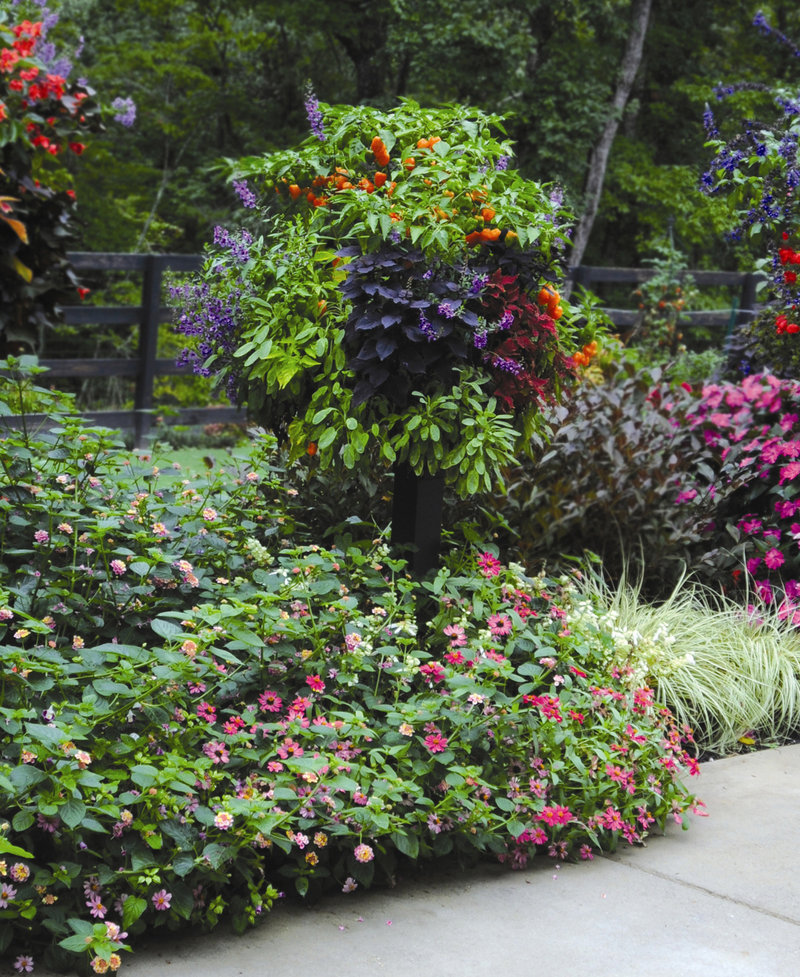Two of the hottest trends in gardening are containers and cultivating fresh food, and many savvy families are beginning to combine the two. They’re growing their vegetables in pots.
Improvements in potting soils and fertilizers have made this a straightforward and generally successful exercise, said Pamela Crawford, a landscape architect from Canton, Ga., who has written four books about container gardening.
“It’s so easy to put a tomato into a pot. It almost grows itself,” Crawford said. “It’s a whole different ballgame than putting one in the ground. There’s less weeding involved and fewer insects to fight. Container gardens are more productive and involve less work.”
Shapely pots and colorful plants are a great combination for growing edibles — especially where garden space is lacking. Containers can deliver the goods and in remarkably large quantities.
“I’ve been able to harvest as many as 236 small spicy peppers all at once from four plants in a 16- to 20-inch container,” Crawford said, referring to habaneros. “I’ve also been able to get my fill of tomatoes from a pot that included a few ornamental sweet potato vines with their large root systems. It’s amazing how little ground space plants need to be productive. They can tolerate being crowded.”
Mixing flowers with ornamental vegetables makes good container sense. Cucumbers, coleus and begonias are eye-catching when planted together. Other great potted pairings include rosemary surrounded by lettuce, viola tucked among some long-legged broccoli plants and spinach growing alongside mounded chrysanthemums. Viola and chrysanthemum petals are edible, by the way.
Adding flowers also extends the life of the combos, Crawford said. “In many of my containers, with flowers that lived much longer than the vegetables, I simply cut the dead vegetable branches off and left the flowers to fill in the remaining space,” she wrote in her latest book, “Easy Container Combos; Vegetables and Flowers” (Color Garden Publishing, 2010).
Most any kind of container will serve, provided it has the necessary openings for drainage. Having too much water in the soil is almost as deadly as having too little. It rots the plant roots.
Baskets are good choices. So are window boxes, kitchen totes and a whole range of recyclables including old barrels, buckets and milk jugs. Just be careful about colors and breathability.
“I’ve had good experience with clay pots and plastic pots,” said Joseph Masabni, an assistant professor and extension horticulturist with Texas A&M University. “If you live in a hot area, I don’t recommend black or dark containers. They can overheat plants. I prefer clay because it breathes if it isn’t coated. (Plant) roots are never starved for oxygen.”
Vegetable gardening in containers is also a good way to involve children. The size of the project won’t be overwhelming, Masabni said.
“Practicality is probably the major consideration. Older people who are still gardeners at heart but who live in apartments also can grow their fill of vegetables or small fruiting shrubs in pots,” he said.
Even people with plenty of land find growing in containers easier with certain produce, such as potatoes, he said.
“There’s no digging required,” Masabni said. “Just tip the pots over and gather up the crop.”
Send questions/comments to the editors.



Success. Please wait for the page to reload. If the page does not reload within 5 seconds, please refresh the page.
Enter your email and password to access comments.
Hi, to comment on stories you must . This profile is in addition to your subscription and website login.
Already have a commenting profile? .
Invalid username/password.
Please check your email to confirm and complete your registration.
Only subscribers are eligible to post comments. Please subscribe or login first for digital access. Here’s why.
Use the form below to reset your password. When you've submitted your account email, we will send an email with a reset code.